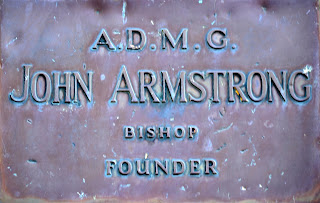St Matthews Mission
 This post was inspired by my resent read, Marguerite Poland's book, Shades.
This post was inspired by my resent read, Marguerite Poland's book, Shades. "The lights moved on, disappearing one by one as the procession dipped towards the drift out of sight below the ridge. There was a stillness then for he could no longer hear the horses' hooves, and only the leaves of the oak before the porch turned restlessly against each other. Beyond, where the bush reached down to the edges of the kitchen garden, the twigs of the thorn trees tapped rhythmically: a small, secret tattoo in the dark."
Sunday morning, 5th July 2015, I called on St Matthews mission, just a few kilometers outside the town of Keiskammahoek, Eastern Cape.
St Matthews Mission was founded in 1855, by Bishop Armstrong on 600 hectares of land in Keiskamahoek donated to the Anglican Church by Chief Socishe.
 |
| Mr. Socishe, Chief Socishe's Grandson |
 |
| Road from the Hoek |
The first building for the mission school was built in 1855 by the Military Chaplain, Dacre, just before the arrival of the Resident Missionary, the Rev H.B. Smith who arrived in September 1855. Rev Smith arrived with Mr Gray, an agriculturalist, Mr Gawula, a school teacher and Mr Finn, an interpreter who was employed by the government.
The first group of scholars enrolled in the school in 1856, a total of 91 scholars. Due to the long distances travelled by the scholars, there were constant requests for boarding accommodation.
One of the buildings was a converted old trading store. The title deed for the mission was issued on the 13th September 1856. The early buildings comprised a dwelling house for the missionary, another for the matron and the boarders, and classroom which also served as a church. These were built from locally available material and well baked bricks with roofs of thatch. Rev Smith left the Mission on the 1st January 1858 to be replaced by Rev W.H.L. Johnson who only stayed a year.
In 1859, Chaplain Dacre was replaced by Rev W. Greenstock, who started on the industrial education centre. Simple trades like carpentry for boys and home crafts, cooking and domestic duties for girls were introduced.
In July 1862, Charles Taberer, aged 19, joined the school as one of the teaching staff.
Charles was to become instrumental in the development and growth of the industrial training centre. The carpentry section flourished which later graduated to Wagon building; a tin-smith’s shop and a printing press.
A hospital and nurses training facility were set up in 1923 and a secondary in 1926. The school was taken over by the Department of Bantu Education in 1955 and in 1970 the state bought most of the St Matthews land. After 114 years of activity in the place, the Anglican Church withdrew its direct involvement with the education programmes at the mission. The hospital was taken over by the Ciskei Government in 1976 and was moved to Keiskammahoek town to become S.S. Gida hospital.
 |
| Perhaps the same piano 'Walter Brownley' used to sit and play "The Corelli" |
 |
| Taberer House |














Comments
Post a Comment